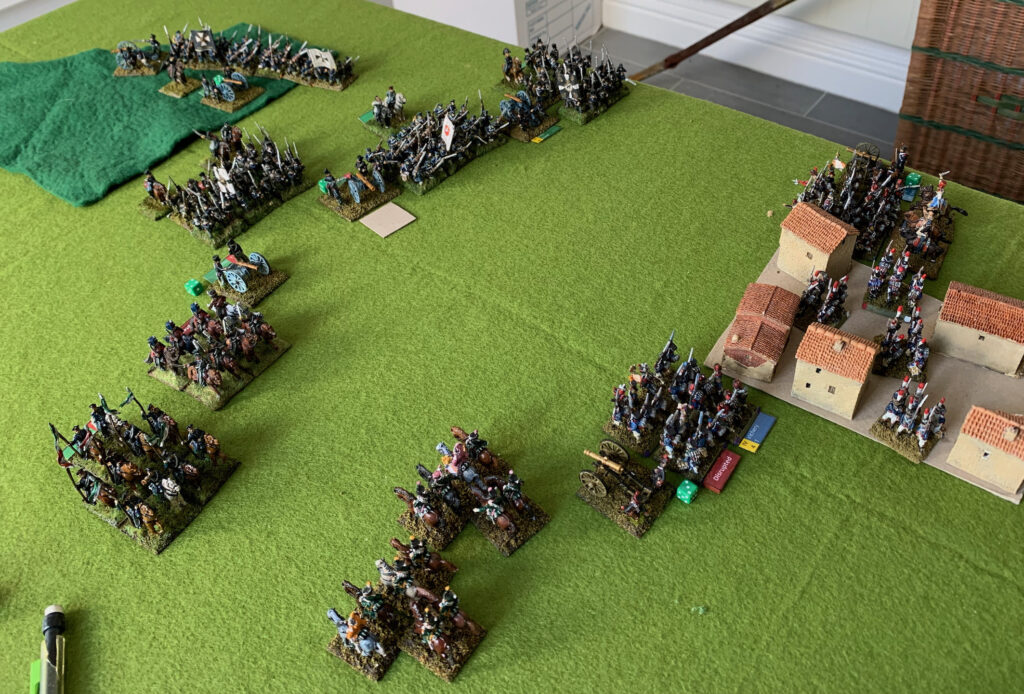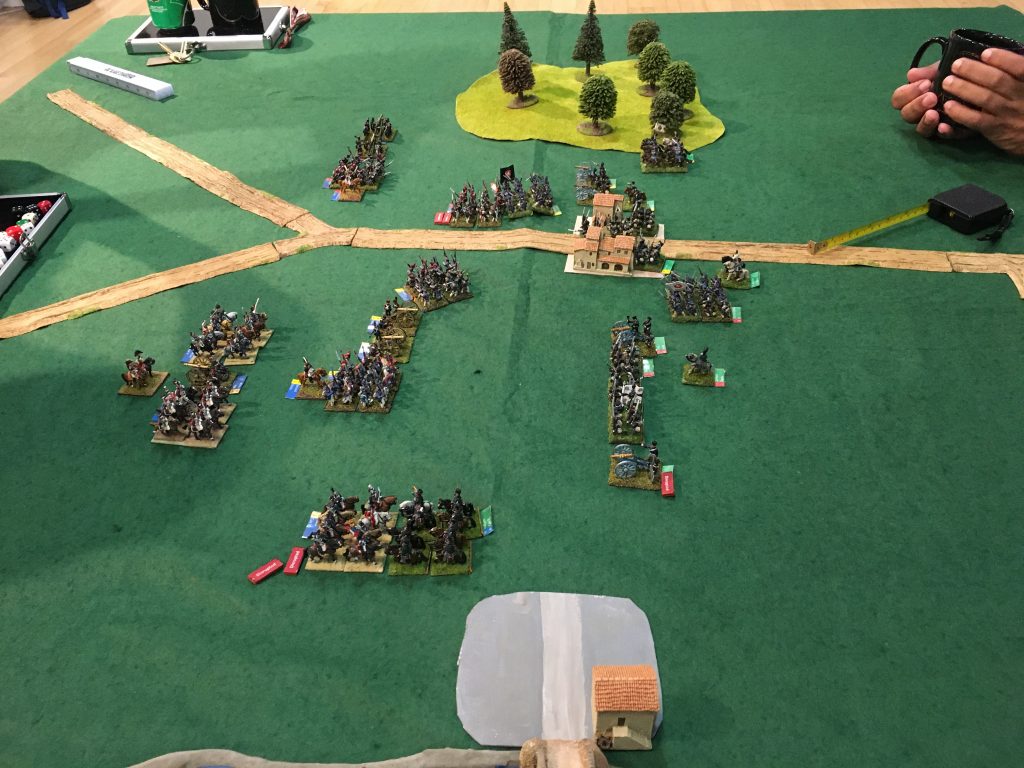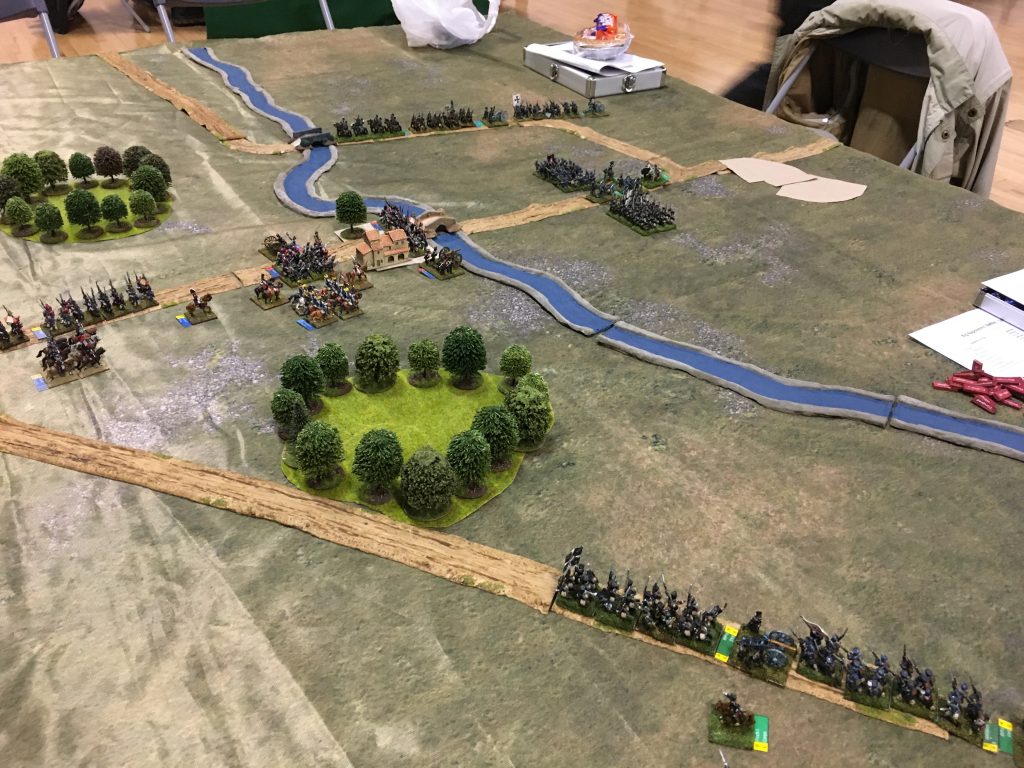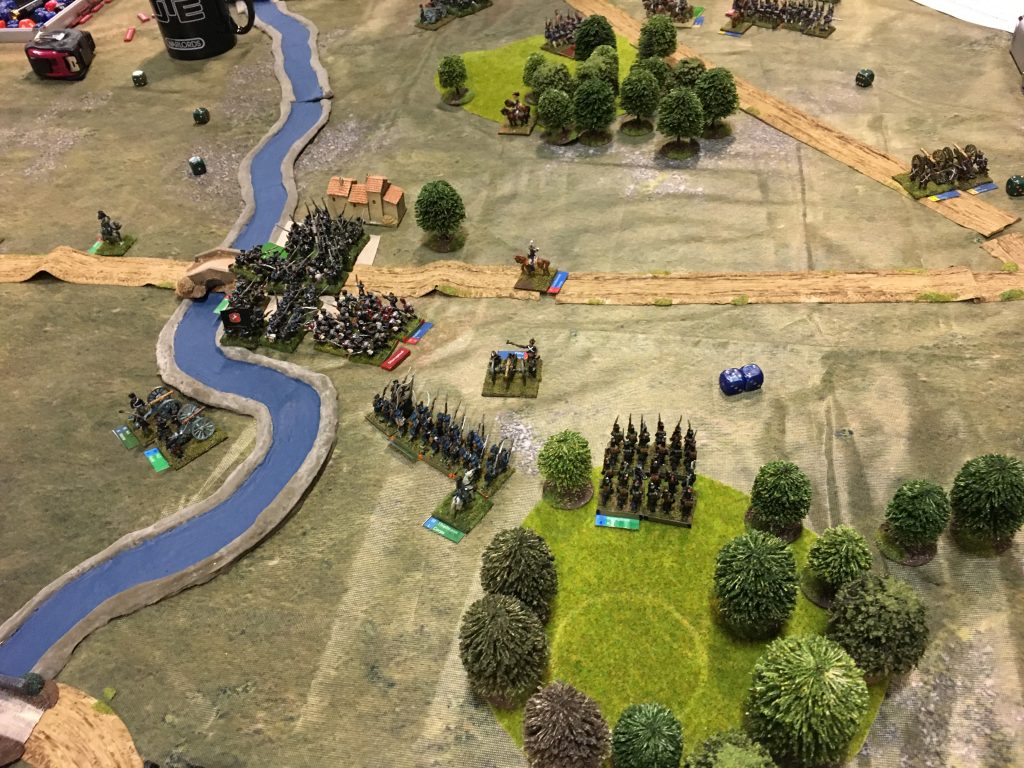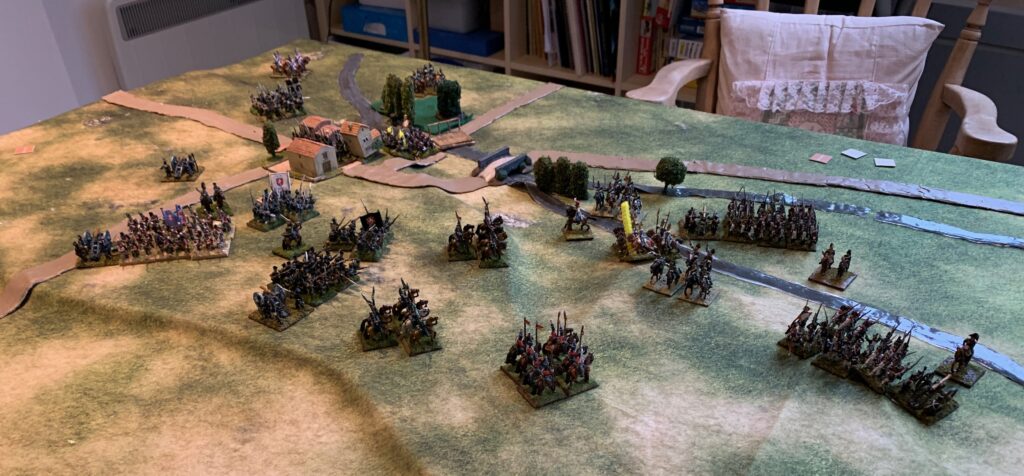
It is one of the strange aspects of Napoleonic wargaming that historically the main focus is on big battles, with over 50,000 men on each side (and on occasions over 150,000 and once double that), while the games themsleves are generally designed to represent much smaller encounters. The January and February issues of Wargames Illustrated feature articles which explore this paradox, from veteran games designers Sam Mustafa and Bill Gray. But my approach to this conundrum is different again from these.
This strange situation is readily explainable. The fashion in the early days was to design games from the bottom up, based on the known capabilities of men, horses and weapons. This led quickly to the basic unit being the battalion, which in turn tied the games to the myriad of accounts of the wars written by the men who took part. There is a lot of drama at this level, and it makes for a cracking game. From a wider perspective it also made a bit more sense than it might first appear: one of the innovations of the age was the use of the division as a manoeuvre element and semi-independent locus of command – and the division was the higher level of organisation around which battalion-based games naturally focused.
So far, so good. But this sort of game makes fighting the big battles, like Waterloo or Borodino impossible without doing strange things – like the practice of “bath-tubbing” – making each battalion stand in for a brigade or division. And the big battles, incorporating the works of the big celebrity generals, like Napoleon, Wellington or Kutusov, are one of the era’s main sources of interest. You are told that you can step in the footsteps of Napoleon, and then given no more than a dozen battalions to play with! It gets worse. One of the attractions of the era is the variety of troop types, and especially elite troops. It’s hard to bring these into an honest division-level game without losing much of the drama that surrounds their use. And you might be able to work in one unit of Imperial Guard, or one of Cuirassiers. But both? And then there are tactics such as massed cavalry or massed artillery that are also very hard to do at divisional level.
And so was born the brigade-unit game. Sam started this with his Grande Armée rules, and then his current Blucher system. Bill did so with his Age of Eagles, based on the Fire and Fury system for US Civil War games. Many gamers are understandably not interested in these systems, so wrapped up are they in the dramas of battalions. It’s simply not Napoleonic without them they say. But for people like me, drawn to the drama of bigger battles, these rules were manna from heaven. For a long time GA, and especially its fast play variant, were my go-to systems. For a number of reasons I outgrew this system, which had weaknesses that Sam himself recognises, and were the reason that he replaced it with Blucher. Meanwhile I developed my own brigade-based system, which I used for my Vitoria game in 2013. These rules were quite innovative – using playing cards instead of dice for example, and did well representing Vitoria, which we played as a four-player game.
But I had a serious problem with brigade games, acknowledged by Bill in his article. The units are too small – and indeed the time interval for a move is too short too – for properly big battles. There are too many units and too many moves to make them accessible either to two players in a day, or to multiple players in an evening – which are the typical formats for most games. This is actually less of an issue with Blucher than Age of Eagles. Blucher is highly abstracted and slick, and a number of its systems are designed to speed up play. I can say similarly for another highly abstracted brigade system – Horse, Foot, Guns by Phil Barker. I have successfully had two player day games with HFG: Salamanca and a stripped back Waterloo (a version that ignores the Prussians but takes out Lobau’s command and the Young Guard). I have played Blucher about three times in evening games with made-up scenarios very loosely based on the core forces at Ligny. But there is something about both the game mechanisms and the look and feel of these games that I don’t like, but that I can’t really articulate. Visually I don’t think they work well with my 15/18mm figures. More seriously they start to get more difficult when the battles get bigger – Salamanca and Waterloo redux are medium-sized battles.
I decided that I had to bite the bullet and use the division as the base unit. Bill says about this: “You lose so many painted miniatures from your visuals that I’d suggestion might as well simply play a board or video game.” Actually the aim is to have the number of miniatures about the equivalent of a normal battalion-based game – say 250-500 a side for 15mm. But he has a point of course – reducing a division of 5,000 men down to a group of 24 miniatures is a stretch. It is probably more tolerable with 6mm or 10mm figures, but that is a road not taken a long time ago for me.
I have encountered two systems with division-sized units. One was by Sam, and based on his GA system. This has a very long distance scale, and large units, represented on standard 2-inch or 3-inch squares. In my one trial game we did Waterloo incorporating most of the Prussian approach march on the table. This produced an interesting game, but it is too scaled down for me. It also suffers many of the faults of the GA system. Then came Bloody Big Battles by Chris Pringle. This is based on Fire and Fury, but is much more scaled up and stripped down than Bill’s game. The system is aimed mainly at mid-19th Century battles, and especially the Franco-Prussian War of 1870-71. But many have used it for Napoleonic. The scaling was exactly what I was looking for though – with 25/30mm square bases representing 1,000 to 1,500 men each, organised into units of three to six bases, usually. My first trial of the system was a solo game between Prussians and Austrians in the 1866 war, using Napoleonic figures. This gave a cracking game with fortunes swinging back and forth wildly. If I start up in this era – and I’m very tempted to – these are the rules that will use (but I’ll use 10mm or 6mm miniatures). It helps that Chris has produced a whole heap of interesting historical scenarios ready to play.
But, as I’ve said a few times here already, BBB does not transfer well to Napoleonic battles. One reason is that the fighting takes too long to resolve – I think because infantry firing is so restricted without long-range firearms. Second is that the command/activation system is very haphazard, so that things can freeze up too quickly in core parts of the battle. This may represent mid-century wars quite well. Central battle control tended to be weak, while local corps and divisional commanders were more used to taking the initiative than earlier in the century. The randomised activation system models this dispersion well enough, but in Napoleonic times the army command tended to be stronger, but lower levels were weaker. The battle flowed quickly in the areas where the army command focused, but tended to be slower elsewhere. Blucher and HFG model this well (HFG overdoes it in fact) – but not BBB. Finally cavalry was much more important in the earlier era, and its role much more distinct from the infantry.
And so for all these reasons I started the journey of writing my new rules with BBB as the jumping-off point. This has produced a series of false dawns, and I’m still not there yet. Partly inspired by Lasalle 2 I have now finally abandoned the I-go U-go turn system. There are other features that I have copied from these wonderfully designed rules. There will need to be more trials before I have anything fit to release, even as a beta.
But one thing is very clear from my journey so far. You lose a lot of the detail with divisional-sized units, and so rely a lot on random combat factors to give a realistic variety of outcomes. This came home forcefully when I tried a thought experiment of recreating d’Erlon’s attack at Waterloo in terms of my rules. The historical outcomes are all possible within the rules, but the route can be a bit indirect at times. But, of course, if you are going to reduce a big battle into something that two players can play in a day, it follows you have to lose a lot. The high randomisation and abstraction is bound to put many off. But it might draw as many others in.
